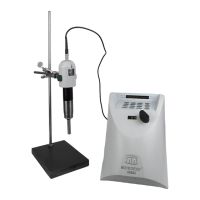Operation Manual Maintenance
9-1
9. TROUBLESHOOTING
WARNING: To avoid electric shock, do not remove the cover from the Generator.
There are no user-serviceable parts inside this device.
Overload Indicator Instructions
The Sonicator
3000 generator is designed to deliver high power to the convertor/horn assembly on a
continuous basis. However, under certain load conditions, the amount of power supplied might
endanger the generator circuitry to the point of failure.
In order to prevent equipment failure, an overload protection feature has been built into the S3000
generator. When the output power exceeds design specifications, the output will be disabled. On the
S3000, the following prompt will appear on the LCD display: "OVERLOAD! Press CLEAR to Reset". Also,
the alarm will beep, and the power knob display will flash showing “888”. When an overload occurs,
proceed with steps 1 - 6 below:
1. Press CLEAR, then shut the unit off using main the power switch.
2. Check all electrical connections.
3. Eliminate contact between horn and sample. For flow cell applications, reduce internal
pressure if necessary.
4. Check tightness of horns and/or tips. Remove tips and clean threads and mating surfaces if
necessary.
5. Check horn for cracks or excessive tip erosion.
6. If all above fails to rectify problem, consult Misonix, Inc. Customer Service Department.
Troubleshooting Guide
SYMPTOM
POSSIBLE CAUSE
REMEDIAL ACTION
System does not turn ON
Power Cord not connected
Check Power Cord
System does not turn ON
Power Outlet off
Check wall socket for voltage
System does not turn ON
Blown line fuse(s)
Check & Replace fuse(s) if
necessary
System is on, but there is no
output
Convertor and/or cable
disconnected
Check all electrical connections
with power turned off.
System is on and properly
connected, but there is no
output
Electronic component failure
Send Unit in for service
When using the temperature
probe, the unit goes into
temperature shutdown
immediately after pressing
START
Maximum shutdown
temperature is set lower than
the measured probe
temperature, or the probe is not
installed properly or is defective.
Program a higher maximum
shutdown temperature.
Program the temperature probe
for temperature monitoring only
to verify the reading of the
probe.

